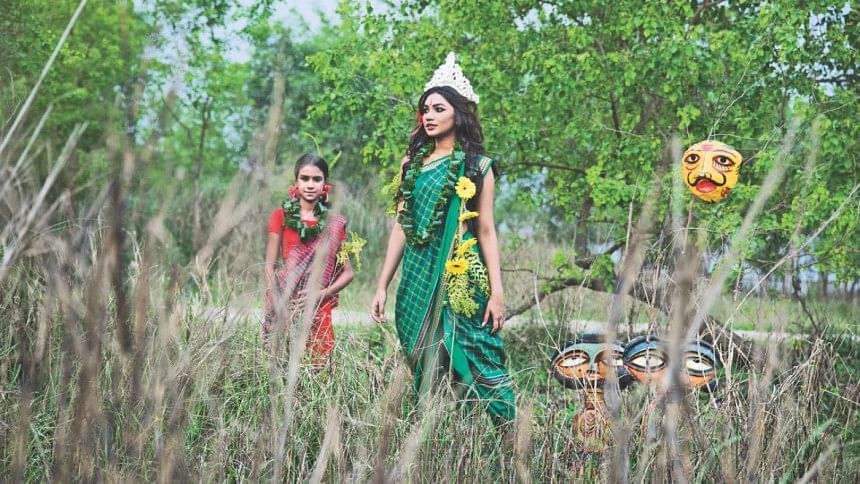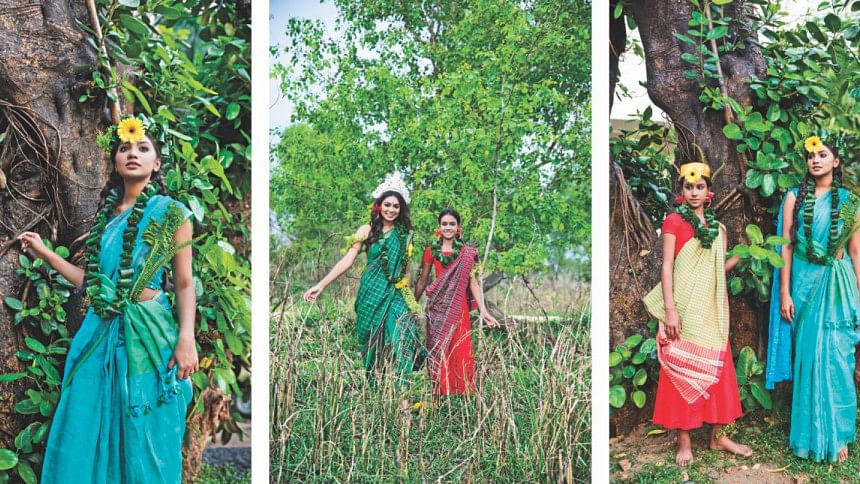Bonbibi: The guardian spirit of the Sundarbans

The tiger was not far away. He saw the large animal that was coming towards him. Fierce. Greedy. Hungry. Death comes in different ways for different people; for the unfortunate boy named Dukhe, it took the form of the fearsome tiger. And afraid he was, Dukhe. He was, after all, about to die. In that fateful moment of desperation, what else could one do but pray? And the boy prayed:
“Kohe Maa Bonbibi kotha roile ei shomoy,
Joldi kore eshe dekho tomar Dukhe mara jai.
Karar diyacho maago jodi na palibe,
Bhatir modhe tomar kolonko roye jabe.”
In that fateful moment of desperation, Dukhe prayed to Bonbibi to save him. After all, Bonbibi is the Mother of the Forest, the supreme authority of the jungle. She is the benevolent deity who can save believers from the dangers that lie in the depths of the Sundarbans, including the much-feared tiger.
And so, as Dukhe summoned Bonbibi, she came to his rescue—unleashing her powers, “defeating” the tiger, and saving the boy.
Dukhe’s tale is, of course, a part of the Bonbibi folklore.
But the goddess is more than a mere mythological character. She is regarded as the guardian spirit of the Sundarbans. For those who live in the surrounding areas, and whose livelihood comes from working in the forest, the notion of Bonbibi as a saviour is strongly embedded in their culture and belief system.
Take the case of Aminur Shana, who lives in a village near the Sundarbans. A honey collector for around 10 years, venturing into the forest has become a part of his everyday life; and so has the vulnerability that comes with it.
He says that fear does not overwhelm him. “I enter the forest in the name of Allah and I feel safe,” he explained. And then he added, “But occasionally when I sense any danger of tigers or snakes, I ask Maa Bonbibi for protection.”
Seeking refuge from Bonbibi gives him courage. “You are my mother. As your son, protect me from the tigers and other dangers of the forest,” Shana would say in his mind when he feels vulnerable.
What is it that makes people like Shana—honey collectors and woodcutters and so on—call upon Bonbibi? What makes this deity so special? Why is a folk deity so important—and relevant to this day—to the people of the Sundarbans?
To answer these questions, we simply need to look at the image that the world’s largest mangrove forest has. The Sundarbans is the abode of not just the Royal Bengal Tiger, but also crocodiles and snakes. Moreover, it may be argued that when one finds himself very deep in a large forest, it is instinctive to feel defenceless and vulnerable. And let’s not forget the storms which visit time and again.
These harsh realities may have been responsible for the emergence of Bonbibi.
Sutapa Chatterjee Sarkar, in her book, The Sundarbans: Folk Deities, Monsters and Mortals, wrote: “In fact, battling with the hostilities of nature was so overwhelming an aspect of the settlers’ lives in these areas that it led to the evolution of deities, to whom they could appeal for refuge psychologically during difficult times.”
The deities of the forest are the gods and goddesses of woodcutters, beeswax gatherers and the like. As Sarkar explained in her book, these are “deities with whom the man in the forest could identify himself.”
And it is rather inspiring that deities like Bonbibi transcend mainstream religions, unifying the people of the Sundarbans under a common pantheon. And hence, even though Shana, our honey gatherer, is a Muslim, he has respect for the guardian spirit of the forest.
His fellow villager Prince Mondal Pintu, who is a craftsman (sculpting Hindu idols), also shares a similar belief in Bonbibi. In addition to making idols of mainstream Hinduism, he makes statues of Bonbibi as well, for the Bonbibi temples in the forest.
“I imagine her in a red sari, wearing red bangles. She is very beautiful. I use the colour orange for her face,” he says.
There are some differences in the depictions or portrayals of the deity, but, according to Sarkar, she is commonly adorned with wild flowers and creepers on her head and around her neck.

According to Sundarbaner Lokayatoghayan O Lokosangskriti (edited by Rafiqul Islam Khokan), in a version of Bonbibi, she has braided hair, wears tupi, tikli, garland of wild flowers, various kinds of necklaces, and ghagra and orna. In another version, she is wearing a mukut (crown) and is adorned by jewellery.
Bonbibi has also been depicted through the age-old punthi, a hallmark of Bengali literature and oral tradition.
In “Bonbibi Jahuranama”, a punthi (manuscript) of Bonbibi, it is mentioned that her father was from Mecca. She even has a brother who goes by the name Shah Jangli. The narration also features Dakkin Rai, another supernatural entity; fearsome and monstrous.
“The temples recite Bonbibi-related punthi,” Pintu informed.
For the temples, Pintu doesn’t only make the idol of Bonbibi, but also that of her brother and other characters of the punthi, such as a small boy on her side or on her lap.
This boy is none other than our Dukhe. Remember the scared Dukhe in the beginning of our story, who was saved from the tiger after he prayed to Bonbibi?
How did he end up in front of a tiger, though?
Well, the story goes that Dukhe was accompanied by Dhonai and Monai, who were in pursuit of honey and wax. However, despite their best efforts, they could not find any.
Then, Dakkin Rai—Bonbibi’s nemesis—appeared in Dhonai’s dream. Sacrifice Dukhe, and you will get what you want, he demanded.
And hence the horror of Dukhe: he was betrayed and abandoned, and left helpless. And Dakkin Rai disguised himself as a tiger in order to kill Dukhe and feast on him.
But Bonbibi, when called upon, rescued the boy, “defeating” the tiger.
Do we see the underlying concept here? What is the relationship between Bonbibi and her rival Dakkin Rai?
Come to think of it, Dakkin Rai demanded that someone needs to be sacrificed. Then the same Dakkin Rai takes the form of a tiger to attack the boy. And it is none other than Bonbibi who comes to the rescue!
Now, dissecting the folklore, one may say that Dakkin Rai is actually an allegorical representation of the man-eating tiger!
“Dakshin Ray, it is clear, is the fierce spirit of the tiger who must be propitiated; Banabibi, on the contrary, is the embodiment of the forest itself, cast in a feminine form,” Sarkar wrote.
Pintu, the idol maker, added to it: “In the temples, Dakkin Rai is often depicted as a tiger.”
The reality of tigers and other dangers in the Sundarbans is still prevalent today as it was generations ago. This conflict between man and nature is perhaps what makes Bonbibi so important to the people of the Sundarbans.
She is their saviour, their guardian, for whom no threats that lurk in the bewildering forest are strong enough to run untamed.
As long as the mystery and apprehension surrounding the forest remain—and it is only natural that they shall remain forever—so will its guardian spirit.
Bonbibi is timeless.
Dukhe’s quotation/prayer has been collected from Lokayatoghayan O Lokosangskriti (edited by Rafiqul Islam Khokan). The book has also been used for Bonbibi Jahuranama in general.
Photo: Sazzad Ibne Sayed
Model: Sunera and Maria
Styling : Sonia Yeasmin Isha
Makeup: Farzana Shakil Makeover Salon

 For all latest news, follow The Daily Star's Google News channel.
For all latest news, follow The Daily Star's Google News channel. 



Comments